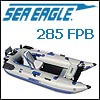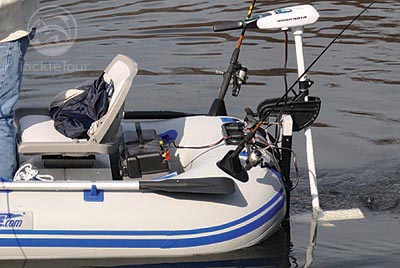
| Date: | 5/20/09 |
| Tackle type: | Watercraft |
| Manufacturer: | Sea Eagle |
| Reviewer: | JIP |
Introduction: For those who don't own traditional boats and look for an alternative way to get on the water, Sea Eagle has many available portable fishing options. The latest of which is the new Sea Eagle 285 FPB, a frameless pontoon fishing boat which is designed to be lighter yet still offer a wealth of angler friendly features.

Introducing the new Sea Eagle 285
FPB
Sea Eagle Past Reviews: Before we get into the details of this new fishing machine let's take a look at the past Sea Eagle reviews here on TackleTour. Our very first Sea Eagle review was back in 2002 with the PaddleSki, a combination of a catamaran and kayak that can be used for paddling, motoring, rowing, sailing, and fishing. To this date we still use the PaddleSki as it's one of the most versatile inflatable watercrafts out there.
Then later that same year we reviewed the
Sea
Eagle 8, an inflatable raft rigged for fishing, and though a classic
product is still among the mot popular in the lineup. Though we found it was a very
stable fishing platform to stand on, the entire rig was not as easy to maneuver
unless equipped with an electric or gas motor.

Standing up to fish is not a
problem with the SE 285 FPB
Finally in our last in-depth review in
2006 we took a look at the well designed
Sea Eagle FoldCat.
This two person watercraft is easy and quick to set up, can be
rowed or motored, and offers excellent stability (so good that there is now a 4
person version). They even have an optional casting stabilizing bar for you to
lean or grab onto when standing up to fish. We have thus far found Sea Eagle
boats to offer portability, high quality construction, and the fact the company
is adding innovative features specifically for anglers is a major plus.

You can use an electric motor or
gas motor up to 3 HP, or you can use the provided oars to row yourself around
New Sea Eagle 285 FPB: Now we take a look at the new Sea Eagle(SE)
285 FPB (Frameless Pontoon Boat). The SE 285 is a U-shaped inflatable that
almost looks like an oversized float tube, it is designed to be powered with either a gas or electric motor, or
good old fashioned oars. When it comes to ease of setup Sea Eagle claims it takes only 5
minutes to inflate and rig this boat.

The optional motor mount
Here are the detailed specifications of the Sea
Eagle 285 FPB:
|
Sea Eagle
285 FPB Specifications and Included Items
| |
| Size | 9 ft long x 4 ft wide |
| Weight | 42 lbs (hull weight) |
| Air Chambers | 2 separate air compartments |
| Persons | 1 adult or up to 450 lbs |
| Material | 1000 denier polyester PVC |
| Rod Holders | 2 built-in |
| Footrest | Aluminum step bench/footrest |
| Flooring | Full fabric |
| Carry Handles | 4 |
| Motor | Electric or gas up to 3HP |
| Stow Bag | 1 clip-on pouch |
| Seat | Inflatable |
| Oars | 2 aluminum oars |
| Pump | Foot pump |
| Storage | Nylon carry bag |
| MSRP | $499.00 |

Included is a clip-on stow pouch
The SE 285 FPB is designed to be rugged, lightweight,
and ultra portable weighing in at only 42 pounds and when deflated,
can be packed into a small bag and transported in any vehicle. Transportation is
made easier because the entire
boat is frameless. With the SE 285 FPB's design no metal
frames are needed for stability.
|
Optional
Equipment
|
| Motor mount for electric or gas motor up to 3 HP |
| Swivel Seat |
| Floor board |

Two rod holders are built right into the
back of the inflatable

Conclusion: Inflatable boats offer a blend of performance, portability, and value for anglers, especially those who enjoy hitting remote lakes or don't want to deal with maintenance that accompanies a traditional boat. Even though I personally run a Boston Whaler on most of my field tests, the Sea Eagle inflatable lineup has always been my choice when fishing smaller lakes where hand launching is possible. The Sea Eagle 285 FPB is the company's latest offering and does what Sea Eagle is best known for, building small, easy to carry, and quick to set up watercraft. Unlike many other inflatable boats it is specifically designed for fishermen, and with innovative features like two integrated rod holders this boat is sure to please anglers on the go. The Sea Eagle 285 FPB will be available at the end of May 2009 and can be bought directly from Sea Eagle's website. Stay tuned as we put this boat through the paces in an upcoming full fledged review. Eastern Sierras here I come.


























